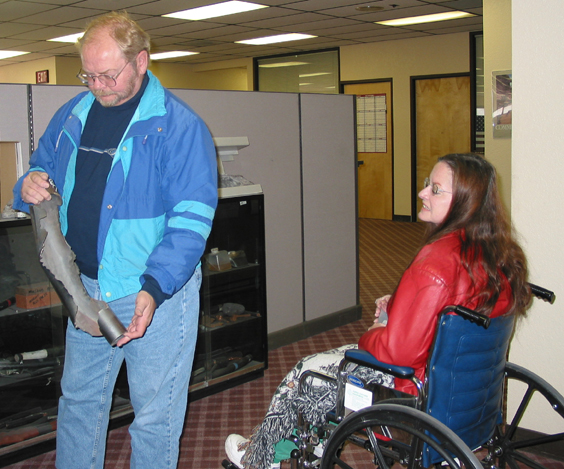New Year's 2004:
Big power, deep powder, and a close encounter with a Mexican Gray Wolf
On the afternoon of December 31 we met Sue and Rob at the Springerville Power Plant and Rob gave us a tour. It really is quite a remarkable operation. The plant is in the middle of nowhere, in the barren cinder-cone-pocked plains north of the Mogollon Rim. But it uses state-of-the-art technology to generate electricity for distant Pima and Cochise Counties.
Two trains per day bring coal from Indian Country across the border in New Mexico. The train cars are tipped upside down to shake out the coal and the hitchhikers. Then the coal is ground finer than talcum powder before being flash-fried in a boiler eight stories tall.

Rob shows us specimens from the "Black Museum" of things that have gone terribly wrong at the plant, like shooting clinkers off the boiler walls and forgetting not to use real bullets!

We spotted a bald eagle winging overhead south of Sringerville, but by the time we got to Alpine we were in dark blue clouds with 3-4 inches of snow on the ground. It's hard to believe that there's winter just a few hours from tank top and sandal country! We took a short drive up the Williams Valley Road after supper and came across a flock of Merriam's turkeys.

The next morning we continued up the mountain to Hannagan Meadow Lodge. The lodge is at 9100 feet -- more than 1000 feet higher than Alpine -- and we were pleased to find that there was JUST enough snow for cross-country skiing. We did 2-3 runs around the lodge, stopping in between times to enjoy the bright sunshine on the porch and watch the resident coyote "mousing" in the field across the road.

At breakfast we heard that a Mexican Gray Wolf had been sighted a few miles from the lodge. There are only about 200 of these wolves left in 40 zoos in the U.S. and Mexico, but five years ago the U.S. Fish and Wildlife Service released 60 of them in the mountains that straddle the Arizona-New Mexico border. On our way to hike the KP Rim Trail, we spotted the wolf trotting along the highway. He had a broken leg -- which is probably why he was on the road -- but he was a magnificent creature. Somehow I managed to snap a few photos, but the wolf looked at me as if to say, "Hey I'm in trouble here, can't you do something besides take my picture?"

When we reached Blue Vista, David had a signal on his cell phone so we called the Fish and Wildlife Service in Mesa. They immediately sent two rangers to try to track down the injured wolf. They even came to the lodge looking for us and asked for copies of my photos, and we got to ask them lots of questions about the Mexican Gray Wolf Reintroduction Project. There are 27 named, numbered and radio-collared wolves in the Blue Range. The lack of a collar identified our wolf as one of approximately 10-15 adults born in the wild since the project began in 1998.
